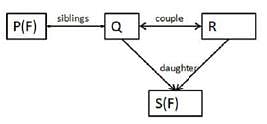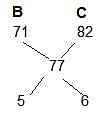HPPSC HPAS Prelims Paper 2 Mock Test - 7 - HPPSC HPAS (Himachal Pardesh) MCQ
30 Questions MCQ Test HPPSC HPAS Mock Test Series 2024 - HPPSC HPAS Prelims Paper 2 Mock Test - 7
Arijit and Brajesh, working together, can complete a task in 10 days, whereas Brajesh and Chandan can finish the same job in 15 days working together. If Arijit works for 5 days and Brajesh works for 8 days, it takes Chandan 9 days to complete the rest of the task. How many days will Chandan take to finish the same job alone?
What temperature threshold defines a heat wave in the plains of India?
Which group is notably missing from many existing Heat Action Plans in India?
What is a major issue with the current Heat Action Plans in India?
How do heat waves affect informal workers in urban settings?
What essential infrastructure is lacking at many work sites for informal workers during heat waves?
Why is it important to include the voices of worker communities in Heat Action Plans?
What is the primary purpose of granting Special Category Status (SCS) to certain states in India?
Which of the following factors is NOT considered when determining whether a state qualifies for Special Category Status?
What significant change occurred in the financial assistance structure to Special Category States following the abolition of the Planning Commission?
The present ages of three persons in proportions 4 : 7 : 9. Eight years ago, the sum of their ages was 56. Find their present ages (in years).
Directions to Solve
In each of the following questions find out the alternative which will replace the question mark.
Question -
Tree : Forest :: Grass : ?
Study the following information and answer the questions that follow:
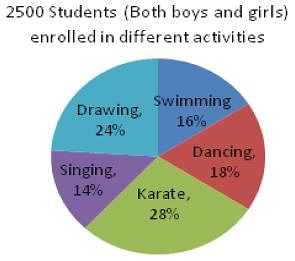
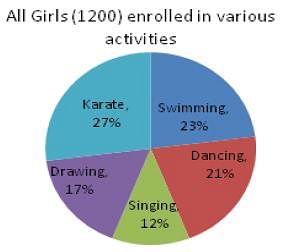
One pie chart shows the percentage distribution of the total number of students (Boys and Girls) enrolled for different activities in School A, and the other pie chart shows the percentage distribution of the total number of girls enrolled for different activities in School A.
Q. The total number of boy students enrolled in dancing and singing together is approximate what percentage of the total number of girl students enrolled for the same activities?
Study the following information and answer the questions that follow:
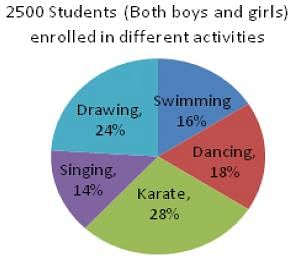
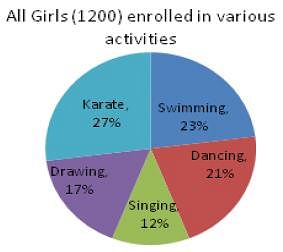
One pie chart shows the percentage distribution of the total number of students (Boys and Girls) enrolled for different activities in School A, and the other pie chart shows the percentage distribution of the total number of girls enrolled for different activities in School A.
Q. Find the ratio of the total number of boy students enrolled for dancing and swimming together to that of girl students enrolled for drawing and karate together.
Study the following information and answer the questions that follow:
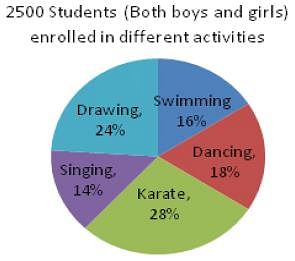
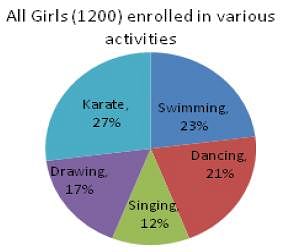
One pie chart shows the percentage distribution of the total number of students (Boys and Girls) enrolled for different activities in School A, and the other pie chart shows the percentage distribution of the total number of girls enrolled for different activities in School A.
Q. The total number of students enrolled in singing and swimming together is approximate what percentage more/less than the total number of girl students enrolled for dancing, drawing and karate together?
Read the information given below carefully and answer the following question.
Technological progress continues to accelerate and at some point, the technology of “mind uploading” becomes possible. Some human individuals upload and make many copies of themselves. Meanwhile, there is gradual progress in neuroscience and artificial intelligence, and eventually it becomes possible to isolate individual cognitive modules and connect them up to modules from other uploaded minds. Possibly, modules would need to be trained before they can communicate with each other effectively. Modules that conform to a common standard would be better able to communicate and cooperate with other modules and would therefore be economically more productive, creating a pressure for standardization. There might be multiple standards; some modules might specialize in translating between incompatible standards. Competitive uploads begin outsourcing increasing portions of their functionality: “Why do I need to know arithmetic when I can buy time on Arithmetic-Modules Inc. whenever I need to do my accounts? Why do I need to be good with language when I can hire a professional language module to articulate my thoughts? Why do I need to bother with making decisions about my personal life when there are certified executive-modules that can scan my goal structure and manage my assets so as best to fulfill my goals?” Some uploads might prefer to retain most of their functionality and handle tasks themselves that could be more efficiently done by others. They would be like hobbyists who enjoy growing their own vegetables or knitting their own cardigans; but they would be less efficient than some other uploads, and they would consequently be outcompeted over time.
Q. Which of the following is important for making copies of humans?
Read the information given below carefully and answer the following question.
Technological progress continues to accelerate and at some point, the technology of “mind uploading” becomes possible. Some human individuals upload and make many copies of themselves. Meanwhile, there is gradual progress in neuroscience and artificial intelligence, and eventually it becomes possible to isolate individual cognitive modules and connect them up to modules from other uploaded minds. Possibly, modules would need to be trained before they can communicate with each other effectively. Modules that conform to a common standard would be better able to communicate and cooperate with other modules and would therefore be economically more productive, creating a pressure for standardization. There might be multiple standards; some modules might specialize in translating between incompatible standards. Competitive uploads begin outsourcing increasing portions of their functionality: “Why do I need to know arithmetic when I can buy time on Arithmetic-Modules Inc. whenever I need to do my accounts? Why do I need to be good with language when I can hire a professional language module to articulate my thoughts? Why do I need to bother with making decisions about my personal life when there are certified executive-modules that can scan my goal structure and manage my assets so as best to fulfill my goals?” Some uploads might prefer to retain most of their functionality and handle tasks themselves that could be more efficiently done by others. They would be like hobbyists who enjoy growing their own vegetables or knitting their own cardigans; but they would be less efficient than some other uploads, and they would consequently be outcompeted over time.
Q. According to author, what are the advantages of mind uploading?
1. It helps humans to be more economically productive.
2. Same type of persons lives in a community that will decrease the conflict of Interests.
3. Every human will have same capability.
P is Q’s sister. Q is married to R. S is the daughter of Q and R. How is S related to P?
In a certain coding language, HENCE is coded as FGLEC. What shall THERE be in that code?
If a man cycles at 10 kmph, he arrives at his office at 1 PM. If he cycles at 15 kmph he will arrive at his office at 11 AM. At what speed must he cycle to get to the office at noon?
Anjali is as much younger to Vijaya as Tanya is younger to Anjali. If the sum of the ages of Vijaya and Tanya is 48, how old is Anjali?
Read the information given below carefully and answer the following question.
Cybercrime is an evolving form of transnational crime. The complex nature of the crime as one that takes place in the border-less realm of cyberspace is compounded by the increasing involvement of organized crime groups. Perpetrators of cybercrime and their victims can be located in different regions, and its effects can ripple through societies around the world, highlighting the need to mount an urgent, dynamic and international response.
Q. Which among the following is the most logical and rational inference that can be made from the above passage?
There are three classes A, B and C with a certain number of students in each of them.In a given test, the performance of the students of various classes is measured. It is found that the average mark of Class A students is 80. The average mark of Class B students is 71. The average mark of Class C students is 82. If the average mark of Class A and B students combined is 75, and the average mark of Class B and C students is 77, then the average mark of the three classes is?
Read the information given below carefully and answer the following question.
Collective bargaining is a key means through which employers and their organizations and trade unions can establish fair wages and working conditions. It also provides the basis for sound labour relations. Typical issues on the bargaining agenda include wages, working time, training, occupational health and safety and equal treatment. The objective of these negotiations is to arrive at a collective agreement that regulates terms and conditions of employment. Collective agreements may also address the rights and responsibilities of the parties thus ensuring harmonious and productive industries and workplaces.
Q. Which among the following is the most logical and rational inference that can be made from the above passage?
Read the information given below carefully and answer the following question.
Much has been said and written about what foreign direct investment (FDI) in retail can do. Depending on which side of the ideological divide is speaking, the assertions are either that it is a magic wand to fix many big problems or that it is a destroyer of honest livelihoods, with little benefits of its own. What is common to both sides is that they are mostly low on fact, high on opinion and generate enormous amounts of confusion. Which is why, I think it is necessary to sift through all of the nose and look truth in the eye. The facts, as I see it, tell us that it has become a symbolic issue, far beyond what reality demands it ought to be; and that there is no need for either great celebration or for deep despair over the idea that FDI in retail is now a reality. My analysis tells a fairly straightforward story.
The government has hugely exaggerated the quantum and immediacy of benefits it put on the table to sell the policy-that common man will benefit enormously, employment generation will be huge, the country’s supply chain will be transformed and large numbers of small producers and farmers will gain. As things stand, even if modern retail were to take off on all cylinders, these arguments would still not hold water for the next 10 years.
For one, there is the fact that aside from very old markets like America and Europe, in most newly developed markets, modern trade accounts for only 20-25 percent of all retail. India is already at 8 percent-which is significant – but the impact hasn’t been as dramatic as one would have assumed.
Then there is the fact that the economics of the Indian market is such that it makes little sense for global retailers to focus on all consumers. I am convinced they will focus their energies on the top 33 percent of urban Indian households (a mere 10 percent of all Indian households); investing in the others isn’t quite what they know how to do profitably yet.
As for small manufactures, I don’t see that huge numbers of them will benefit. Retailers across the world like to work with a small group of select vendors because it makes for better profitability. So yes, a small number will benefit significantly. And yes, employment will be generated. But it won’t be anywhere close to the numbers now being touted.
Then there is the argument that encouraging modern retail to invest will provide the much-needed booster shot for the country’s dismal supply chain infrastructure. Here again, let’s face it. Retailers aren’t in the business of building national infrastructure. About the only infrastructure they’d be interested in is their last mile.
The only argument that holds true is that kiranas or the small, traditional shopkeepers who are now an Indian staple, will not die. But that is a tribute to the small shopkeeper rather than prescience on the part of the government.
Q. According to the author, which of the following is not a common attribute of the arguments put forth by the pro-and anti FDI ideologues?
1. Likely to be false.
2. Judgmental.
3. Positive about FDI in retail.
4. Strongly opposed to FDI in retail.
Read the information given below carefully and answer the following question.
Much has been said and written about what foreign direct investment (FDI) in retail can do. Depending on which side of the ideological divide is speaking, the assertions are either that it is a magic wand to fix many big problems or that it is a destroyer of honest livelihoods, with little benefits of its own. What is common to both sides is that they are mostly low on fact, high on opinion and generate enormous amounts of confusion. Which is why, I think it is necessary to sift through all of the nose and look truth in the eye. The facts, as I see it, tell us that it has become a symbolic issue, far beyond what reality demands it ought to be; and that there is no need for either great celebration or for deep despair over the idea that FDI in retail is now a reality. My analysis tells a fairly straightforward story.
The government has hugely exaggerated the quantum and immediacy of benefits it put on the table to sell the policy-that common man will benefit enormously, employment generation will be huge, the country’s supply chain will be transformed and large numbers of small producers and farmers will gain. As things stand, even if modern retail were to take off on all cylinders, these arguments would still not hold water for the next 10 years.
For one, there is the fact that aside from very old markets like America and Europe, in most newly developed markets, modern trade accounts for only 20-25 percent of all retail. India is already at 8 percent-which is significant – but the impact hasn’t been as dramatic as one would have assumed.
Then there is the fact that the economics of the Indian market is such that it makes little sense for global retailers to focus on all consumers. I am convinced they will focus their energies on the top 33 percent of urban Indian households (a mere 10 percent of all Indian households); investing in the others isn’t quite what they know how to do profitably yet.
As for small manufactures, I don’t see that huge numbers of them will benefit. Retailers across the world like to work with a small group of select vendors because it makes for better profitability. So yes, a small number will benefit significantly. And yes, employment will be generated. But it won’t be anywhere close to the numbers now being touted.
Then there is the argument that encouraging modern retail to invest will provide the much-needed booster shot for the country’s dismal supply chain infrastructure. Here again, let’s face it. Retailers aren’t in the business of building national infrastructure. About the only infrastructure they’d be interested in is their last mile.
The only argument that holds true is that kiranas or the small, traditional shopkeepers who are now an Indian staple, will not die. But that is a tribute to the small shopkeeper rather than prescience on the part of the government.
Q. With which of the following about the benefits of FDI in retail would the author agree?
1. The common man may not benefit greatly.
2. Employment generation may not be that huge.
3. Farmers and small producers shall be benefited greatly.
The average mark of 15 students in a CSAT test is 50. If the average mark of the first eight students is 47 and that of the last eight students is 55, then what will be the marks of the 8th student?
A tank has two pipes – A and B, attached to it. A can fill the tank in 20 minutes, whereas pipe B can empty the tank in 30 minutes. If both A and B are opened alternately for one minute each, how long will it take to fill the tank?
At a specific rate of simple interest, a sum doubles itself in 5 years. In how many years will it becomes four times itself?
Read the information given below carefully and answer the following question.
This article was written in 1978.
Recent years have brought minority-owned businesses in the United States unprecedented opportunities—as well as new and significant risks. Civil rights activists have long argued that one of the principal reasons why Blacks, Hispanics, and other minority groups have difficulty establishing themselves in business is that they lack access to the sizable orders and subcontracts that are generated by large companies. Now Congress, in apparent agreement, has required by law that businesses awarded federal contracts of more than $500,000 do their best to find minority subcontractors and record their efforts to do so on forms filed with the government. Indeed, some federal and local agencies have gone so far as to set specific percentage goals for apportioning parts of public works contracts to minority enterprises. Corporate response appears to have been substantial. According to figures collected in 1977, the total of corporate contracts with minority businesses rose from $77 million in 1972 to $1.1 billion in 1977. The projected total of corporate contracts with minority businesses for the early 1980‘s is estimated to be over 53 billion per year with no letup anticipated in the next decade. Promising as it is for minority businesses, this increased patronage poses dangers for them, too. First, minority firms risk expanding too fast and overextending themselves financially, since most are small concerns and, unlike large businesses, they often need to make substantial investments in new plants, staff, equipment, and the like in order to perform work subcontracted to them. If, thereafter, their subcontracts are for some reason reduced, such firms can face potentially crippling fixed expenses. The world of corporate purchasing can be frustrating for small entrepreneurs who get requests for elaborate formal estimates and bids. Both consume valuable time and resources, and a small company’s efforts must soon result in orders, or both the morale and the financial health of the business will suffer.
Q. According to the passage, civil rights activists maintain that one disadvantage under which minority-owned businesses have traditionally had to labour is that they have



 20x = 80
20x = 80 Their present ages are 4x = 16 years, 7x = 28 years and 9x = 36 years respectively.
Their present ages are 4x = 16 years, 7x = 28 years and 9x = 36 years respectively.
